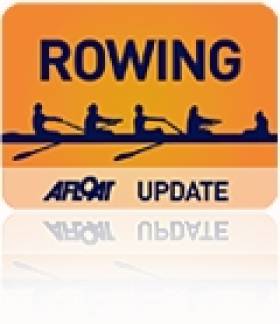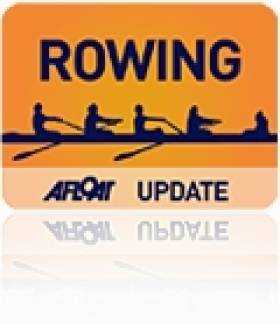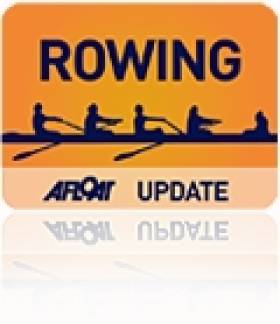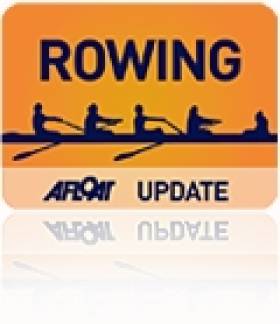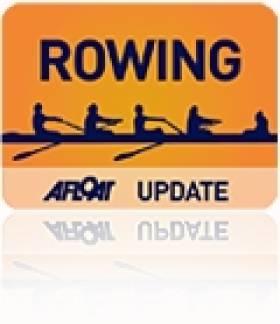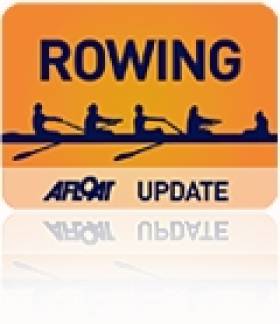Displaying items by tag: Dukarska
Dilleen and Kennedy Second in European Heat
#ROWING: All four Ireland crews are set for repechages after today's first session of heats at the European Rowing Championships in Belgrade in Serbia. The women’s pair of Leonora Kennedy and Lisa Dilleen came a creditable second to Romania in their heat, but only one automatic qualification place was on offer. Women’s single sculler Sanita Puspure also finished just one place off qualification, in third, in a race won by Olympic champion Mirka Knapkova. The Ireland women’s double of Monika Dukarska and Eimear Moran were fifth in their heat.
Earlier, Paul O’Donovan had finished third in his heat of the lightweight single sculls.
European Rowing Championships, Belgrade, Serbia – Day One (Irish interest; selected results)
Men
Lightweight Single Sculls – Heat Three (First Two to A/B Semi-Finals; rest to Repechage): 1 Italy (M Miani) 6:56.92, 2 Bulgaria (N Vasilev) 6:59.35; 3 Ireland (P O’Donovan) 7:02.21, 4 France 7:06.95, 5 Turkey 7:16.58.
Women
Pair – Heat Two (Winner to A Final; rest to Repechage): 1 Romania (C Grigoras, L Oprea) 7:14.51; 2 Ireland (L Kennedy, L Dilleen) 7:18.77, 3 Croatia 7:21.87, 4 Serbia 7:24.46, 5 Germany 7:32.40.
Double Sculls – Heat Two (First Two to A Final; rest to Repechage): 1 Poland (M Fularczyk, N Madaj) 6:46.50, 2 Britain (F Houghton, V Thornley); 3 Netherlands 6:54.59, 4 Czech Republic 7:10.63, 5 Ireland (M Dukarska, E Moran) 7:16.66.
Single Sculls – Heat Three (First Two to A/B Semi-Finals; rest to Repechage): 1 Czech Republic (M Knapkova) 7:29.98, 2 Netherlands (C Acterberg) 7:31.64; 3 Ireland (S Puspure) 7:39.26, 4 Sweden 7:48.13, 5 Latvia 7:51.24.
Ireland Rowers Kennedy and Dilleen Win Again in Italy
#ROWING: Leonora Kennedy and Lisa Dilleen won again at the Memorial Paolo d’Aloja international regatta in Piediluco this morning. The Ireland pair put four Italian crews behind them to match their win on Saturday. The Ireland double of Eimear Moran and Monika Dukarska slipped back one place on yesterday. They finished fourth in their final, behind two Italian crews and the Belgian crew of Jeanne Ghuysen and Marine Lewuillon.
Memorial Paolo d’Aloja, Piediluco, Italy (Irish interest)
Women
Pair: 1 Ireland (Kennedy, Dilleen) 7:30.0, 2 Italy (Arcangiolini, Marzari) 7:43.67, 3 Italy Two (Basadonna, Bellio) 7:47.89.
Double Sculls: 1 Italy Two (Schiavone, Palma) 7:20.55; 4 Ireland (Moran, Dukarska) 7:30.78.
Ireland Rowing In Medals at Italian Regatta
#ROWING: Ireland crews took medals on the first day of finals at the Memorial Paolo d’Aloja in Piediluco in Italy. Sanita Puspure was second behind Donata Vistartaite of Lithuania in the women’s single sculls, with Magnaghi Sara of Italy third. The women’s double of Eimear Moran and Monika Dukarska took bronze in a final where they were the only non-Italian crew.
High Five for Rowers as Irish Sports Council Confirms Carding
#ROWING: A relatively good 2013 for Irish international rowing will bring practical benefits this year. Five rowers, three more than last year, will receive funding from The Irish Sports Council under the 2014 International Carding Scheme. Sanita Puspure and Claire Lambe have again hit the mark: Puspure qualifies for €20,000 as a world class category athlete and Lambe receives €12,000 as an international class competitor. The two are joined this year by Paul O’Donovan, Leonora Kennedy and Monika Dukarska, who will also be granted €12,000 as international class athletes.
O’Donovan won a medal at the World Under-23 Championships in 2013, while the women’s double sculls of Dukarska and Kennedy finished 10th at the World Championships. This position would secure Olympic qualification for an Ireland boat if it were reproduced at the World Championships next year.
Kennedy and Dukarska are Afloat Rowers of the Month for August
#ROWING: The Afloat Rowers of the Month for August are Leonora Kennedy and Monika Dukarska. The Enniskillen woman, who had rowed and won medals with Britain, and her Killorglin teammate only began to work together earlier this summer, yet they formed a women’s double which finished a creditable 10th at the World Rowing Championships in Chungju in Korea. As preparations for the new season begin, this crew gives hope that Ireland rowing may begin to gather momentum again on the world stage.
Rower of the Month awards: The judging panel is made up of Liam Gorman, rowing correspondent of The Irish Times and David O'Brien, Editor of Afloat magazine. Monthly awards for achievements during the year will appear on afloat.ie and the overall national award will be presented to the person or crew who, in the judges' opinion, achieved the most notable results in, or made the most significant contribution to rowing during 2013. Keep a monthly eye on progress and watch our 2013 champions list grow.
Tenth in World Rowing for New Crew of Kennedy and Dukarska
#WRChamps: Ireland had a good finish to its campaign in the World Rowing Championships in Chungju in Korea this morning. The new women’s double scull of Monika Dukarska and Leonora Kennedy took fourth in their B Final, tenth overall in this Olympic-class event. Meghan O’Leary and Ellen Tomek of the United States won the contest at the head of the field with Russia and the Ukraine, and the Irish won their battle with Italy and Korea. Italy pushed hard at the 1500-metre mark; Kennedy and Dukarksa saw them off with a good final quarter.
World Rowing Championships, Chungju, Korea, Day Eight (Irish interest)
Women
Double Sculls – B Final (Places 7 to 12): 1 United States (M O’Leary, E Tomek) 6:56.05, 2 Russia (E Potapova, M Kraskilnikova) 7:01.07, 3 Ukraine (A Kravchenko, O Buryak) 7:03.34, 4 Ireland (M Dukarksa, L Kennedy) 7:06.80, 5 Italy 7:09.04, 6 Korea 7:11.75.
Ireland's New Women's Double Fifth in World Rowing Semi-Final
#WRChamps: Ireland’s new double scull of Leonora Kennedy and Monika Dukarska finished fifth in their semi-final at the World Championships in Chungju in Korea this morning and will compete in a B Final on Sunday. The semi-final was won well by Frances Houghton and Victoria Meyer-Laker, with Germany and Denmark filling second and third and taking the resultant places in the A Final. Ukraine took fourth, while Ireland pushed Italy into sixth early in the race and stayed in front of the crew in blue until the finish.
World Rowing Championships, Chungju, Korea, Day Six (Irish interest)
Women
Double Sculls – Semi-Final (First Three to A Final; rest to B Final): 1 Britain (F Houghton, V Meyer-Laker) 7:18.56, 2 Germany (J Lier, M Adams) 7:19.10, 3 Denmark (M Petersen, L Jakobsen) 7:29.30; 4 Ukraine 7:34.27, 5 Ireland (M Dukarska, L Kennedy) 7:39.33, 6 Italy 7:39.50.
Lightweight Single Sculls – C Final (Places 13 to 18): 1 Italy (D Zacco) 8:05.21, 2 Ireland (C Lambe) 8:07.38, 3 Korea (Yoo Jin Ji) 8:08.75, 4 Japan 8:18.46, 5 Singapore 8:24.11, 6 India 8:32.05.
Kennedy and Dukarska Give Ireland Place in World Championship Semis
#WRChamps: Monika Dukarska and Leonora Kennedy reached the A/B Semi-Finals at the World Championships in Korea this morning. The Ireland double scull had to make the top three in their repechage to qualify, and they finished second behind Russia and ahead of Korea, who took the third qualification place. The Russians, who had to give way to Ireland in the heats, were pillar-to-post winners, but the new Ireland crew maintained a steady pace behind them.
The Olympic and World Champion in the men's single sculls, Mahe Drysdale of New Zealand, could only finish fourth in his quarter-final and failed to make the semi-finals.
World Rowing Championships, Day Three (Irish interest)
Women
Double Sculls – Repechage (First Three to A/B Semi-Finals; rest to C Final): 1 Russia (E Potapova, M Krasilnikova) 7:09.81, 2 Ireland (M Dukarska, L Kennedy) 7:12.08, 3 Korea (A Kim, Y Kim) 7:17.95; 4 Taipei 7:44.92, 5 Namibia 9:22.05.
Good Second Half Not Enough for Ireland Women's Double
#WorldRowingChampionships: Ireland’s double scull of Monika Dukarska and Leonora Kennedy took fourth in their heat at the World Rowing Championships in Chungju in Korea this morning and must compete in a repechage to secure a place in the A/B Semi-Finals.
A place in the top three was the target: Lithuania and Denmark were the clear one-two from half way, with Ukraine in third and Ireland and Russia trailing. Dukarska and Kennedy upped their rate in the second half of the race, engaging in a battle with Russia which they won. They overlapped Ukraine in the closing stages but could not head them.
World Rowing Championships, Day Two (Irish interest)
Women
Double Sculls – Heat One (First Three Directly to A/B Semi-Final; rest to Repechage): 1 Lithuania (D Vistartaite, M Valciukaite) 6:52.09, 2 Denmark (M Petersen, L Jakobsen) 6:56.34, 3 Ukraine (A Kravchenko, O Buryak) 7:02.42; 4 Ireland (M Dukarska, L Kennedy) 7:03.92, 5 Russia 7:09.73.
#WorldUniversityRowing: Monika Dukarska finished fourth in the women’s single sculls at the World University Summer Games at Kazan in Russia today. The A Final was won by Natalia Dovgodko of the Ukraine in six minutes 13.76 seconds. Dukarska, who is from Killorglin, finished in six minutes 27 seconds.
World University Summer Games, Kazan, Russia (Rowing, Irish interest)
Women
Single Sculls – A Final: 4 M Dukarska 6:27.00.
Lightweight Single Sculls – A/B Semi-Finals: 4 A Bulman 6:18.39.




























